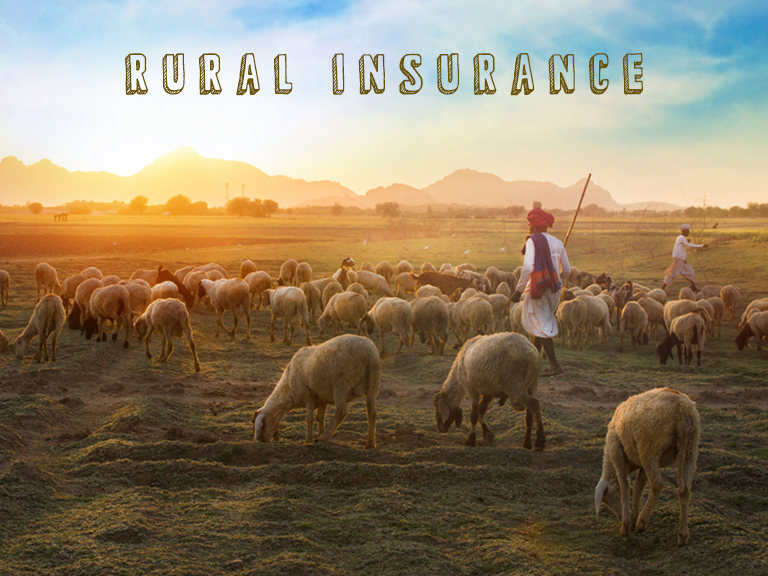India is endowed with huge number of villages and about 70% of population live in Rural India having Agriculture and allied occupations as their livelihood. One third of Indian people are below poverty line. Having limited resources and facing natural calamities often, farmers continue to suffer poverty despite various poverty alleviation schemes and measures by Government and NGOs.
From the view point of Insurance, there is un measurable potential for the lives and assets to be covered with available schemes and also there is a vast potential for devising need based Tailor made policies. Due to change of Technology in Agri and Animal Husbandry, the need for insurance is growing due to the reason of higher investments / loans- example being Solar Pump sets & Milk Chilling Centres. Union Govt and State Govts at various times declared and implemented insurance schemes to support farmers and Rural people with insurance subsidies and also helping in marketing their produce.
In our Country, about 60 % of Rural households have livestock as an integrated form of farming system. Therefore, among various Rural Insurance schemes, Cattle Insurance is the major contributor of Rural Insurance premium income for General Insurers. Agriculture forms 15 % of contribution of GDP in India. About 69% of women are engaged in Agri and allied Sector. Livestock contributes 26 % in total Agriculture GDP.
IRDAI has mandated insurers as per Sec 32-B and 32-C of Insurance Act, 1938 to show procurement of insurance premium from remote and rural areas by way of a regulation – “Obligations of Insurers under Rural and Social Sector-2002, amended in 2015 ” under which, Insurers are obliged to generate certain %ge of premium from Rural and Social Sectors and no. of lives covered under Social Sector to keep their licence valid.
Rural area as per IRDAI specification is as follows:
- Has a population of less than 5000
- The density of population in the area must not be more than 400 per square kilometre.
- A minimum of 75% of the male working population must be engaged in agriculture related work.
The mandatory specification for Insurers to procure minimum premium and No. of lives to be covered from Rural Area and Social Sector is as below:
Rural Sector: 2 % of premium for the first year of operation.
3% for 2nd year, 5 % from 3rd to 7th year , 6 % in 6th year and 9% from 7th financial years onwards.
Social Sector: The % of minimum coverage of lives compared to policies issued and total no. of persons insured ranges from 0.5% to 5 % at the end of 10 years of operation of insurers.
Through the above regulations, there is compulsion for insurers to penetrate into Rural Market and serve the heart of our Country. But, still we have to go a long way, since we have huge potential with 195.60 Million Rural Households in which, 104.52 Million cattle are owned with a present penetration of 0.6% farmers insured and 0.9% of Cattle Insured. It will give a good understanding of the untapped potential and the distance we have to travel. According to United Nations Development Programme (UNDP), the market potential in Cattle insurance in India is 41.81 to 62.71 Million animals. Apart from cattle, Poultry, Fisheries, Crop Insurance, Plantation & Horticulture, Rural Assets insurances have excellent insurance potential.
India has the highest population of cattle and is the highest producer of Milk. India’s Livestock population is estimated to be 50.42 Million as per Livestock Census , 2019. Some of the states having higher population of Cattle are: U.P., Rajasthan, A.P., Punjab, Bihar, West Bengal, Gujarat, Karnataka and Tamil Nadu. Govt. of India’s National Livestock Development Scheme has helped lacs of farmers in many states to insure their cattle with a subsidised premium which enabled them to replace milch cattle with insurance compensation when they lose animals on account of death and also when animals become unproductive due to Diseases.
Another initiative by insurers to promote Insurance in Rural Areas is through “ Micro Insurance Schemes”. These are policies similar to Rural Insurance policies with limited sum insured and lighter premium, which is affordable even by weaker section of the Society. Schemes offered ranging from Personal Accident, Health, Cattle and other animals, Rural assets such as Agri. Pump sets, Drip irrigation, Honey bee, farmers’ Package Policy and so on. IRDAI have specified norms and monitor with suitable regulations to reach huge number of poor and needy groups. Simple Micro Insurance schemes covering PA, Health and assets of Self Help Group Women have made it possible to cover millions of Women and Girl Children. Still, we have to go a long way to register a milestone in Rural Insurance in India.
The main reasons for low penetration are attributed by the following:
- Lack of Insurance awareness among public,
- Lack of sufficient distribution channels,
- Unaffordability by farmers and weaker sections,
- Lack of interest by insurers – due to low ticket premium and having a mind-set that Rural schemes are loss prone, which is totally a wrong notion.
- Lack of comprehensive cover for all crops and all risks in Crop Insurance,
- There is no continuous research and product development in Rural policies as in case of health insurance.
It is to be noted that cattle and other Rural Insurances are profit making continuously even with the small percentage of penetration. Rural insurance is a Small Ticket- High Volume Business, which is to be restructured by reducing premium rates and increasing the base, so that, it will benefit both the Society and Insurers in a long run. It is certainly possible if insurance awareness is created in at least 25 % of about 6 lacs villages in our country. It is to be recalled that during 1990s’ when cattle insurance was considered as one of the major sources of premium income, there was a thinking to form a separate Rural Insurance Corporation , but the proposal was declined by Insurers due to the reason , they did not want to lose the profitable portfolio and retain loss making ones with them. Hence, it is clear that Rural Insurance has great potential and we need better strategies to develop the portfolio to strengthen the roots of economy in India.


